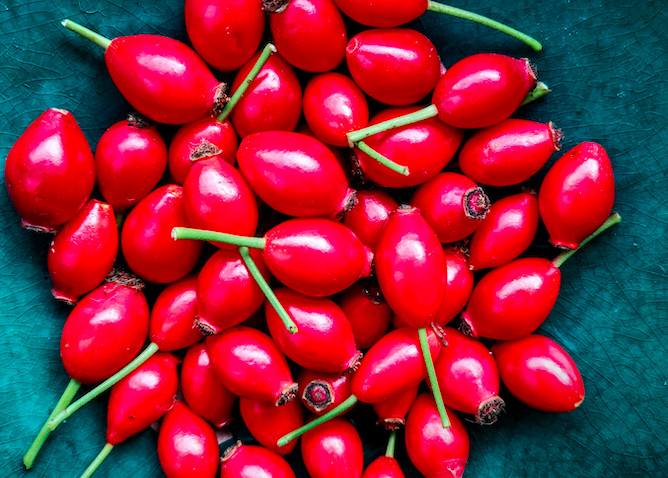
One of winter's wonders, the rosehip is a versatile addition to any home kitchen and bar. Anistatia Miller and Jared Brown reveal some of their favourite uses for this flavoursome fruit.
For gardeners, the first frosts signal it’s time for autumn and winter fruit and veg to don their horticultural fleece and polytunnels. Honestly, the growing season in this household doesn’t take much of a rest. But early winter does yield a surprising treat, especially if you grow roses and live near a wild rose hedge. That’s right – rosehip harvest time is upon us. Those bright-red berries that are the last remnant of beautiful spring and summer blooms. Some folks like to decorate their holiday wreaths with them in lieu of holly. Some like to gather them and stick them in the fridge for a few months so they can attempt to grow rose bushes from seed the following spring. Personally, we don’t like waiting the year or so for a rose bush to grow and bear flower. We’d rather take advantage of the citrussy, bright character rosehips can offer the winter kitchen and bar.
As a child of the ’50s, my [Anistatia] first encounter with rosehips involved drinking rosehip tea sweetened with a touch of honey. By the ’60s, I’d graduated up to tisanes that combined rosehips with dried hibiscus and a touch of dried orange peel. I discovered the joys of rosehip jam on granary toast a decade later, followed by combining rosehip jelly in a shaker with vodka to make a Rosehip Martini.
If you’re in a foraging mood or have cultivated rose bushes, make your own jam. Take 450g of fresh rosehips, remove the green stems, and pulse them in a food processor. Chop 1k of Cox or similar late-harvest apple, leaving the cores and peels intact. Put all the fruits into a pot and cover with water, then add a little more for good measure. Cook the mixture until the rosehips are tender. Pour the mixture through a jelly bag and leave to strain overnight. Do not squeeze the contents – it will cloud the jelly. Measure your liquid. For every 600ml of rosehip and apple, add 400g of caster sugar to the pot. Stir to dissolve and slowly bring to a boil until the mixture reaches 105°C on a cooking thermometer. Take off the heat and cool a little before pouring into sterilised jars and sealing.
Entertaining solution
Now you could, of course, take the time and effort to make a damned good rosehip wine. But if you don’t have the time, patience, space, or equipment to process five gallons of a fruit wine that will take months to clear and another year to mature to optimal potability, we’ve got an entertaining solution from the world of ferments: rosehip soda. Three cups of fresh rosehips with stems removed go into a pot with two litres of water. Bring to a boil and turn down to a simmer for 30 minutes. Cool this mixture overnight. Strain through a jelly bag. Stir in 255g of honey until dissolved. You’ve now made a great rosehip syrup. But wait – there’s more!
Pour the mixture into a sterilised glass demijohn. Add two or three tablespoons of whey from a container of strained yogurt. (It’s the watery stuff that forms in your yogurt container after you first dig in and return it to the fridge.) Pop an airlock on the demijohn and place it in a warm, dark place (22-27°C is optimal for fermentation). Wait three days or more, tasting to see if you have achieved a light fizziness and slightly reduced sweetness. It might take an extra day to achieve this, but it is an organic process after all. Pour the soda into clip-top bottles and store in the fridge. Use it up within a week or two. And regularly check you haven’t built up too much pressure from the gases forming in your soda. Rosehip soda and whiskey make a fun combo as a Highball. The syrup you made as the base for your fermented soda also works a treat for making a Rosehip Whiskey Smash.
Now, if you’re looking for holiday gift inspiration, we’ve got you covered. Stem three cups of rosehips, place in a clip-top jar with a litre of super-premium London Dry gin. Do not use cheap gin – your finished gift will taste cheap. Steep this mixture for about six weeks. When you’ve got your colour and flavour balance, stir in caster sugar or honey to taste. Strain and bottle.
Did we mention rosehips are packed with vitamin C and antioxidants? Well, they are. We just got too carried away thinking about the taste benefits of this late-year harvest. Enjoy.


